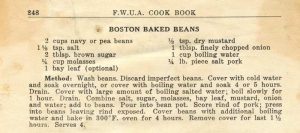Baked Beans
2016 was the year of the “pulse” and it’s not too late to acknowledge this very important Canadian crop and food source. The word “pulse” comes from the Latin puls meaning thick soup or potage. Pulses are the edible seeds of plants in the legume family [i], which includes plants whose fruit is enclosed in a pod. Gardeners and farmers appreciate legumes because they fix nitrogen into the soil which reduces the need for chemical fertilizers.
Pulses are versatile in cooking; and on a bitterly cold day, not much can beat an old-fashioned pot of baked beans and pork oven-cooked for a few hours. It’s easy to make baked beans from scratch, given sufficient time.
The F.W.U.A. Cook Book has my sister-in-law Rita Milligan’s favourite baked beans recipe. It’s entitled “Boston Baked Beans” and its main ingredients in addition to navy beans are molasses, brown sugar, bay leaf, dry mustard, finely chopped onion and salt pork. A French-Canadian equivalent, feves au lard substitutes maple syrup for molasses.
In her 1990 publication, “Jean’s Beans”, Jean Hoare claims that ‘baked beans built the west, just as surely as that railway stretching from sea to sea”[ii] . She tells the story of a young Mountie who had an innovative packaging idea for baked beans. He baked up a big batch, poured it into long stockings, hung the stockings outside to freeze solidly and whenever he wanted a meal, he just chopped off a length of stocking and heated up the right amount of beans.
Maybe you have the ingredients in your cupboards to make versatile, tasty historic baked beans.
References:
[i] http://www.pulsecanada.com/about-us/what-is-a-pulse
[ii] Hoare, J. (1990). Jean’s Beans. Port Coquitlam, BC: Spirit of Cooking Publishing. p.1

